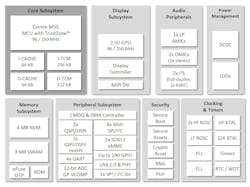Ultra-Low-Power AI-Enabled Microcontroller is SPOT On
Check out Electronic Design's embedded world 2024 coverage.
What you’ll learn:
- What is subthreshold optimized technology (SPOT)?
- Why is SPOT important for AI on the edge?
- What is inside the Apollo510?
Ambiq made a name for itself delivering ultra-low-power microcontrollers based on standard Arm Cortex-M platforms. SPOT, or subthreshold optimized technology, is the company’s chip design approach that requires significantly less power than even competing low-power microcontroller solutions.
I talked with Scott Hanson, Ambiq’s CEO, about their latest Apollo510 (see figure) based on the Arm Cortex-M55 with the Helium ARMv8.1-M machine-learning (ML) and artificial-intelligence (AI) hardware-acceleration support. They also used lower voltages and a more aggressive design with new deep-sleep modes.
Scott noted that more than three quarters of the developers incorporating AI/ML into their applications don’t require a dedicated neural processing unit (NPU). As a result, using the Cortex-M55 provides improved AI/ML performance while keeping power requirements low. The nerualSPOT AI optimized support includes software platforms such as Voice-on-SPOT, HeartKit, SleepKit, and PhysioKit that are designed to work with sensors. They also take advantage of the Helium AI/ML instructions.
The 250-MHz Apollo510 comes with 4 MB of nonvolatile MRAM and 3.75 MB of RAM. MRAM is fast and maintains better write characteristics compared to flash memory. It can handle a range of off-chip memory devices at speeds up to 250 Mtransfers/s via a pair of HexSPI interfaces.
The chip can be used in user interface applications using its 2D/2.5D GPU. It supports memory-in-pixel (MiP) with fast-forward along with a pair of MIPI DSI interfaces that run at 768 Mb/s.
Arm’s TrustZone is the basis for security with the Apollo510 and includes secure-boot support. Ambiq’s secureSPOT offers additional protection against remote attacks. They also provide secure lifecycle management as well as secure debug support that can be toggled on and off.
Check out more of Electronic Design's embedded world 2024 coverage.

